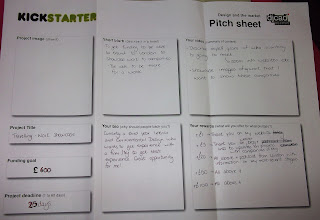To me Mike summed up how important money is for a business in a short sentence perfectly, 'If you don't make money then you don't have a business, you just have an expensive hobby'.
We were given the finance sheet to work through the green section - it was about identify things about yourself such as how much you would like to earn a year, how hard would you work and would you work with a partner/employees, with a few others. You can see my answers in the image below.
 |
| Green section |
We then quickly moved through the next three sections of the sheet, the blue part I personally did not have a clue what to put for most of them - the questions where about annual turnover, competitor prices etc something I do not no anything about. The next part was the orange area which asked questions that I found a little easier as they wanted to find out about what costs will have to be incurred for the business to run. You can see my answers for this in the images below.
The last part of the sheet was about asking questions to get you thinking about the kinds of way you could get finance to set up your business and how long would they be able to cover you for. My answers are seen in the image below.
Direct - making a product or selling a service (materials, labor, advertising)
Indirect - running a business even if you sell nothing (salary, rent, insurance, lawyers)
These two types of costs form a big part in your cash flow along with other factors like the money you take in and dividends etc. You can see from my drawing below how a cash flow works.
 |
| Cash Flow Diagram |
The workshop then moved onto Crowd Funding - describes the collective, cooperation, attention and trust by people who network + pool their money together usually via the internet, to support efforts initiated by people or organisations. This first time I have heard of this type of funding, it seems to be an easy and straight forward way to try to gain finance for a project. The good things about it is that it will secure funding and word of mouth of your product/service etc but the bad thing is that your idea/design is on the internet so anyone could steal it. We were given a KickStarter pitch sheet to fill in on something that we would want to gain money for right now. The image below shows the idea of my pitch - it was to get enough funding to travel to London to show my work.
 |
| KickStarter - Pitch Sheet |
As this was our last NESTA workshop we have been taught as much about business that we need to know at this stage, we should be able to take it forward to help us through our Personal Enterprise Proposal.



No comments:
Post a Comment